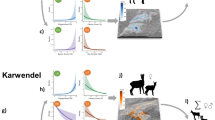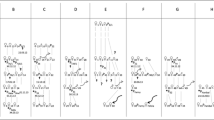Abstract
We studied the sex ratio of goitered gazelles in the naturally arid environment of Kazakhstan over a 6-year period. The main methods in our study were taking transect counts and focal observations. The sex ratio of adult goitered gazelles has demonstrated a female bias due to a much higher mortality of males of all ages, especially during years with unusually severe winters. This phenomenon is typical for many polygynous ungulates, as well as other gazelle species. Surprisingly, our data demonstrated monthly fluctuations in sex proportions, along with a bias shift from a female-dominant population during most of the year to a male-dominant population during spring. We discovered, though, that our data did not reflect any real changes in the sex ratio of the population but, instead, revealed the radical changes in behavior of pregnant females before giving birth—hiding from danger in thick shrubs or broken terrain rather than fleeing. As a result, we were not able to see many pregnant females in our spring samples (before birthing), and so received a male-biased population. During the rest of the year (after birthing), females returned to their usual behaviors of fleeing from danger that then gave us a female-biased sex ratio that reflected a more accurate status in sex proportions of the population. So, our results discovered seasonal sex difference in hiding behavior which led to a bias based on visibility.

Similar content being viewed by others
References
Alados CL, Escos JM (1994) Variation in the sex ratio of a low dimorphic polygynous species with high levels of maternal reproductive efforts: Cuvier’s gazelle. Ethol Ecol Evol 6:301–311
Berger J, Gompper ME (1999) Sex ratios in extant ungulates: products of contemporary predation or past life histories? J Mamm 80(4):1084–1113
Blanchard P, Festa-Bianchet M, Gaillard JM, Jorgenson JT (2004) Maternal condition and offspring sex ratio in polygynous ungulates: a case study of bighorn sheep. Behav Ecol 16(1):274–279
Blank DA (1986) Peculiarities of social and reproductive behaviour of Gazella subgutturosa in the Ili Hollow. Zool Zhurnal 64:1059–1070 (in Russian)
Blank DA (1990) Persian gazelle. In: Kovshar AF (ed) Rare animals of desert regions. Nauka of Kazakh SSR, Alma-Ata, pp 56–80 (in Russian)
Blank DA (1992) Social and reproductive behavior of the Persian gazelle. Ph.D. dissert. The University of Tel Aviv
Blank DA (1998) Mating behavior of the Persina gazelle (Gazella subgutturosa Guldenstaedt, 1780). Mammalia 62(4):499–519
Byers JA, Moodie JD (1990) Sex-specific maternal investment in pronghorn, and the question of a limit on differential provisioning in ungulates. Beh Ecol Soc 26:157–164
Carter S (1991) Goitered gazelle North American regional studbook, 1st edn. Sedgwick County Zoo and Botanical Garden, Wichita, p 87
Cassinello J, Gomendio M (1996) Adaptive variation in litter size and sex ratio at birth in a sexually dimorphic ungulate. Proc Royal Soc B, London 263:1461–1466
Clark AB (1978) Sex ratio and local resource competition. Science 201:163–165
Clutton-Brock TH (1991) The evolution of parental care. Princeton University Press, Princeton
Clutton-Brock TH, Albon SD, Guinness FE (1985) Parental investment and sex differences in juvenile mortality in birds and mammals. Nature 313:131–133
Clutton-Brock TH, Albon SD, Guiness FE (1986) Great expectations: dominance, breeding success and offspring sex ratios in red deer. Anim Beh 34:460–471
Clutton-Brock TH, Coulson T (2002) Comparative ungulate dynamics: the devil is in the detail. Philos Trans Royal Soc B, London 357:1285–1298
Clutton-Brock TH, Iason GR (1986) Sex ratio variation in mammals. Q Rev Biol 61(3):339–374
Cunningham PL, Sandoka M, Wronski T (2011) Some morphological characteristics of Arabian Sand Gazelle Gazella subgutturosa marica and its implications for management. Eur J Wildl Res. doi:10.1007/s10344-011-0498-x
Cunningham PL, Wronski T (2011) Sex ratios of Arabian Sand Gazelle Gazella subgutturosa marica Thomas, 1897 in the Mahazat as Sayd protected area, Saudi Arabia. Mammalia 75:243–248
Ditchkoff SS, Welch ER, Lochmiller RL, Masters RE, Starry WR (2001) Age-specific causes of mortality among male white-tailed deer support mate-competition theory. J Wild Manag 65:552–559
Emlen ST, Oring LW (1977) Ecology, sexual selection, and evolution of mating systems. Science 197(4300):215–223
Festa-Bianchet M (1989) Survival of male bighorn sheep in southwestern Alberta. J Wild Manag 53:259–263
Fitzgibbon CD (1990) Why do hunting cheetahs prefer male gazelles? Anim Beh 40:837–845
Fitzgibbon CD, Lazurus J (1995) Antipredator behavior of Serengeti ungulates: individual differences and population consequences. In: Serengeti II, Sinclair ARE, Arcese P (eds) The University of Chicago. Illinois, Chicago, pp 274–296
Haque MN, Smith TR (1996) Reintroduction of the Arabian sand gazelle Gazella subgutturosa marica in Saudia Arabia. Biol Conserv 76:203–207
Hewison AJM, Gaillard JM (1996) Birth-sex ratios and local resource competition in roe deer, Capreolus capreolus. Behav Ecol 7(4):461–464
Hewison AJM, Gaillard JM (1999) Successful sons or advantaged daughters? The Trivers–Willard model and sex-biased maternal investment in ungulates. Trends Ecol Evol 14:229–234
Kingswood SC, Blank DA (1996) Gazella subgutturosa. Mammalian Species 518:1–10
Kruuk LEB, Clutton-Brock TH, Albon SD, Pemberton JM, Guinness FE (1999) Population density affects sex ratio in red deer. Nature 399:459–461
Rahmani AR (1990) Distribution, density, group size and conservation of the Indian gazelle or chinkara Gazella bennetti in Rajasthan, India. Biol Conserv 51:177–189
Rosenfeld CS, Roberts RM (2004) Maternal diet and other factors affecting offspring sex ratio: a review. Biol Reprod 71:1063–1070
Ruckstuhl KE, Neuhaus P (2002) Sexual segregation in ungulates: a comparative test of three hypotheses. Biol Rev 77:77–96
Rutberg AT (1986) Lactation and fetal sex ratios in American bison. Am Nat 27:89–94
Skogland T (1986) Sex ratio variation in relation to maternal condition and parental investment in wild reindeer. Oikos 46:417–419
Sludskiy AA (1956) The goitered gazelle breeding. Transactions of the Institute of zoology. Kazakh Acad Sci 6:78–108 (in Russian)
Trivers RL, Willard DE (1973) Natural selection of parental ability to vary the sex ratio of offspring. Science 179:90–92
Widdowson EM (1976) The response of the sexes to nutritional stress. Proceed Nutrit Soc 35:1175–1180
Wronski T, Sandouka MA, Plath M, Cunningham P (2010) Differences in sexual dimorphism among four gazelle taxa in the Middle East. Anim Biol 60:1–18
Zhevnerov VV (1984) Goitered gazelle of the Barsa-Kelmes Island, Nauka of the Kazakh SSR, Alma-Ata (in Russian)
Zhevnerov VV, Bekenov AB, Sludskiy AA (1983) Mammals of Kazakhstan. Vol. 3 (3). Nauka of Kazakh SSR, Alma-Ata (in Russian)
Acknowledgments
We are grateful to the International Science & Technology Cooperation Program of China (2010DFA92720), the Chinese Academy of Sciences (Visiting Professorships for Senior International Scientists - 2009Z2-5), the Chinese Academy of Sciences Xi Bu Zhi Guang (LHXZ200701), and SINO-UAE Cooperation Project (0866031) for granting our work and creating all conditions for writing this paper. We thank also the Institute of Zoology, former Academy of Sciences of Kazakhstan, which has given us possibility for investigations of goitered gazelles in natural environment over a 10-year period. We thank Mrs. Patricia Johnston, who did a tremendous initial job editing this manuscript.
Author information
Authors and Affiliations
Corresponding author
Additional information
Communicated by: Dries Kuijper
Rights and permissions
About this article
Cite this article
Blank, D., Yang, W. Sex ratio in goitered gazelles (Gazella subgutturosa Guldenstaedt, 1780). Acta Theriol 58, 73–78 (2013). https://doi.org/10.1007/s13364-012-0097-6
Received:
Accepted:
Published:
Issue Date:
DOI: https://doi.org/10.1007/s13364-012-0097-6




